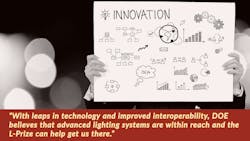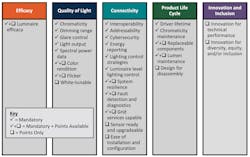The Lighting or L-Prize has been getting a lot of buzz since the US Department of Energy (DOE) rolled it out in May 2021, and I can attest to the great care that went into its design and goals. My background in lighting design, luminaire design, lighting research, and sustainability resonates to the L-Prize focus on product life cycle in particular, which includes aspects such as replaceable components and design for disassembly. For others like me who care about driving sustainability in lighting design and application, there is a lot to be excited about in this L-Prize program.
Beyond life cycle, I can also speak to the care that went into other aspects of the L-Prize — I was involved in its design as part of a cross-cutting team from Pacific Northwest National Laboratory (PNNL), the National Renewable Energy Laboratory (NREL), and DOE. The competition seeks breakthrough concepts for the LED luminaires, sensors, control devices, and interfaces that comprise the lighting systems of tomorrow for the commercial sector.
Those outside the lighting world might be surprised to learn that DOE wants to “light a fire” under the LED, and there is significant development potential remaining in this technology. In those market segments penetrated by LED, the energy savings have been dramatic. At the same time, much higher performance, functionality, and energy efficiency — especially of commercial-grade LED lighting systems — is possible. Digital and data-informed control of intensity, spectrum, distribution, and timing of light to the benefit of occupants’ visual physiological needs would increase lighting value and service per watt. For these reasons, the L-Prize has targeted commercial buildings — a high consumer of energy and a market where LED adoption has lagged.
With leaps in technology and improved interoperability, DOE believes that advanced lighting systems are within reach, and the L-Prize can help get us there with systems that have the potential to better manage lighting energy use, deliver exceptional quality of light as inclusively as possible, integrate with other building systems, streamline maintenance and operations, and even respond to electric grid signals, increasing the value and resiliency of buildings. Folded into the competition is a focus on technologies that feature significant domestic participation in manufacturing, securing US leadership in clean energy technologies.
The L-Prize roll-out occurs in three distinct phases — we’re now in the concept phase and there is time to prepare an entry before the November submissions deadline. We are casting a wide net for participants and ideas, encouraging competitors to imagine a concept luminaire and lighting system of the future, and think beyond the current constraints on lighting innovation such as cost, form factor, materials, and integration.
The concept phase is specifically designed to encourage bold concepts from small or large companies or even a student embarking on a career — innovators with big ideas and a desire to get them in front of a bigger audience. Through the L-Prize, DOE aims to draw on lighting innovations from everybody, with a chance for major players, upstart small companies, garage inventors, and academic teams to take the plunge and submit concepts. All will be taken seriously as demonstrated by the fact that each entrant meeting minimum prize requirements will receive feedback from the expert reviewer panel on their concept proposals and perhaps win a cash prize. Submissions to the concept phase will be treated confidentially, so there is no need to worry about protecting your ideas. The only aspect of any submission that will be released is a public-facing slide and participants will get to decide what is included there.
Concept proposals will be scored for innovation, feasibility, and ability to meet the L-Prize technical requirements. A cash prize of $20,000 will be awarded to up to 10 winners with the highest-scoring concept entries, and my hope is that we’ll see a wide range of innovative approaches that will be making impacts on the lighting community for years to come.
The point of bonus points
As noted, the expert reviewer panel will look at and score every entry that meets prize requirements whether it wins a prize or not. As you can see from check boxes in the nearby figure, the competition includes many innovation-related opportunities for bonus points across the board. Bonus points can be awarded to luminaires and systems that feature color tunability and system resilience through service interruptions, for example, and those that include standardized power, data, and sensor capabilities for connectivity.
Bonus points under the category of Innovation and Inclusion add another important dimension to the innovative nature of the prize. This category offers an open invitation to think beyond the known or easily measurable opportunities for innovation, focusing on both technical ingenuity and pioneering approaches to diversity, equity, and inclusion (DEI) in how systems are designed, produced, deployed, or installed. For example, L-Prize teams could include minority-owned businesses, teams from minority-serving institutions (MSIs) including historically Black colleges and universities (HBCUs), and other minority institutions (OMIs) as well as teams from Opportunity Zones.
These are just a few examples. DOE would like all innovators to be heard from, just as all Americans should benefit directly and indirectly from the technological progress that the L-Prize spurs. Your ideas and innovations to increase inclusion and innovation in lighting as part of your L-Prize submission are encouraged and can earn you points toward a winning submittal.
The first step
Taking the first step toward participation is as easy as visiting the American-Made Challenges website for an overview of the L-Prize competition. By clicking the button to “Compete or Follow the Challenge,” you will visit https://www.herox.com/LPrize for a deeper dive into participation. In order to gain full access to the L-Prize website and to see who might be looking to partner on a submission, click the button “Solve this Challenge” — all you need to provide is your name and e-mail address. As of August 2021, there are 14 teams and 121 innovators registered (some indicating they are looking for team members), and an ever-growing list of questions and answers in the Forum tab. For each team, there’s a Join button to promote both participation and the formation of important alliances. Maybe you already know some of the players or have expertise that makes you a fit on one of the teams. Or maybe you prefer to compete individually.
Registering to “Solve the Challenge” doesn’t lock you in to participate in the concept phase or any phase of the competition, but it does enable you to fully explore the L-Prize website and get a feel for the competition and who’s already involved. In a similar vein, participation in the concept phase doesn’t lock you in to working through the other two phases — the prototype phase and the manufacturing and installation phase. What the concept phase can do is put you on the map and increase your visibility to the lighting community, potential partners, and teams. Entries in each phase will be independently evaluated and prizes will be awarded without consideration as to whether the concept appeared in other portions of the competition. The sky really is the limit in this first phase of the L-Prize as long as the proposed technology meets the competition technical criteria.
For those who are interested in finding partners for subsequent phases, be on the lookout for the L-Prize Teaming Opportunities RFI to be released at the beginning of the prototype phase. In the meantime, take the plunge, find teammates for your concept submission, develop a concept, and rack up those bonus points. DOE wants you and your energy, enthusiasm, and ideas. With the concept phase, the time is now, so let’s get those big ideas out there and make a difference.
Get to know our expert
KATE HICKCOX is a lighting research scientist at Pacific Northwest National Laboratory (PNNL), which is participating in administering the L-Prize program along with the US Department of Energy’s National Renewable Energy Laboratory. Hickcox is a creative thinker in the field of lighting, with over 15 years of experience in both lighting research and lighting design.






